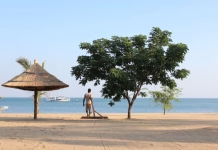
Some residents of Keta and Agavedzi in the Volta region have been displaced by tidal waves yet again.
The latest incident on Sunday, April 3, has left many homeless.
Some moved to higher grounds to seek shelter, while others had no choice but to sleep on mattresses along major roads.
At Keta, the famous Emancipation Beach Resort has been badly affected by the high waves, destroying many properties owned by the facility owner.
Residents who spoke to JoyNews’ correspondent, Ivy Setordjie, lamented the continuous ravaging impact of the sea, adding that the recent waves may cut off streets and make it difficult for people to use the roads.
“We need help. The main street leading into the township has also been submerged, and the school under the waters and means of livelihood are being destroyed.
“We are constantly living in fear due to the continuous ravaging of the sea, and it appears to us that if nothing is done soon and urgently, the whole area will be cut off. Therefore we are appealing to government to look for funding and start a sea defence wall, which seems to be the only solution to our problem,” a resident lamented.
Meanwhile, the Municipal Chief Executive (MCE) for Ketu South, Maxwell Lugudor, says government is committed to making sure their problems are resolved immediately.
He added that he has secured funding to build infrastructures for victims who lost their houses due to the incident.
“I was in the community just yesterday with the engineers to commence work on the land only to hear this afternoon of another devastation by the sea,” Mr Lugudor recounted.
Parts of the Greater Accra Region, specifically the Ada, was also hit by the waves.
At least 3,000 people in Keta municipality have been rendered homeless after tidal waves swept through their homes in November 2021.
Communities such as Abutiakope, Kedzikope and Keta Central were primarily affected as affected homeless residents are left with nothing to salvage.
Keta is a coastal town in the Volta Region of Ghana. It is the capital of the Keta Municipal District.
Keta is sixty-fone on the list of most populous settlements in Ghana, with a population of 23,207.
Parts of the town were devastated by sea erosion between the 1960s and 1980s.
With a coastline of 550 kilometres and a quarter of its population living by the sea, Ghana is particularly affected by coastal erosion. Human activities that amplify the rise in water levels linked to global warming are largely responsible for this.
The increased erosion in Keta suggests that the reduction of coastal sediment supply caused by the Akosombo dam led to the fast erosion of the coastline down-drift the Volta estuary. This situation resulted in a quick recession and devastations on the shoreline and settlement between Keta and Hlove from 1965 to 2002.
The Keta Sea Defense Program was performed to protect and stabilize the shoreline from Keta to Hlorve in the Republic of Ghana, West Africa.
The construction of the 41-million Euro sea defence began in October 2010 and was projected to be completed by December 2011 but was completed in October 2014.
Following the recent developments, the people have called on Government to extend the construction of the Sea Defence Project to the other areas that are also below sea levels and therefore are prone to this disaster.





















